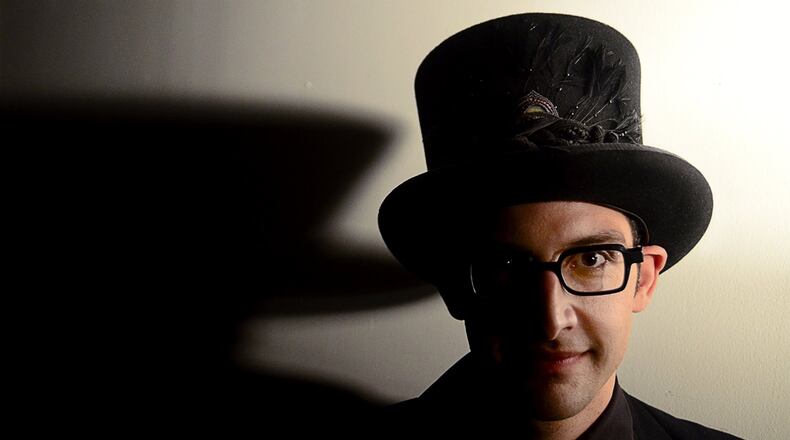In a lifetime full of amazing feats of magic and escape that amazed the world, what was Harry Houdini’s greatest trick? Magician David London gives a simple answer.
“Self-promotion,” he says with a laugh. “Truthfully. His greatest feat was transforming himself into a celebrity.”
London, who has long been fascinated by the legendary escape artist, is the curator of a new exhibition at Atlanta's Breman Museum focusing on the life and work of Harry Houdini. In addition to highlighting the tricks and feats that made Houdini a household name, the show also considers Houdini's genius for self-promotion, in addition to examining an infrequently examined aspect of his identity: his Jewish heritage.
“Harry Houdini wasn’t born, he was created,” says London, who’s based in Baltimore, Maryland. “He was very successful at capturing the world’s imagination, not only during his time, but to this day. I think the most fascinating thing about Houdini is that he does remain so popular.”
Houdini was born Erik Weisz, the son of Rabbi Mayer Sámuel Weisz, in 1874 in Budapest, Hungary. His family immigrated to America when he was just 4 years old. Growing up in Appleton, Wisconsin, the young Erik Weisz became fascinated by show business and magic. After reading the autobiography of a famous French magician named Jean Eugène Robert-Houdin, he adopted the name Harry Houdini and, as London puts it, “never looked back.”
“I got really obsessed with trying to uncover the roots of his Jewish heritage,” says London, who is also Jewish. “Once he changed his name from Erik Weisz to Harry Houdini, he had to hide a lot of his Jewish heritage. It was a very different time then. He performed in Russia at a time when Jews weren’t even admitted to the country, much less able to perform on stage. There have been bits and pieces here and there, but that became a major obsession of mine, to uncover new information.”
In the exhibition, visitors travel through a series of themed displays revealing how Houdini’s identity influenced his career. Sections range from a focus on his early years as a young immigrant working odd jobs to his transformation to a world-famous magician and escape artist.
The exhibition includes key artifacts, including Houdini’s father’s Hebrew Old Testament, signed twice by Houdini himself. Visitors will also see one of Houdini’s prop lists, specifying, among other things, that exactly 18 chairs be placed on stage with him. “The number 18 is significant in Jewish numerology,” explains London. “Eighteen represents chai, or life. He wanted to be surround by life when he was potentially facing death.”
Among the other artifacts visitors will encounter are a variety of handcuffs used in Houdini’s acts, posters and other promotional ephemera, Houdini’s locksmithing guide and a “spirit trumpet,” a device that supposedly amplified the voices of the deceased. Houdini used the prop to debunk the many sham spiritualists and fortune tellers who were popular at the time.
A small section explores Houdini’s visits to Atlanta when he stayed at the former Ansley Hotel downtown, spoke at the Atlanta Women’s Club and performed at the former Forsyth Theatre on the corner of Forsyth and Luckie streets.
London says that his research also helped him see a little bit of the man behind the myth. “He spent his entire life performing in vaudeville which meant he was performing 20 minute shows, maybe three times a day,” says London. “He had an abundance of time backstage with which to engage in intellectual pursuits. All of that was interesting, to start to understand the life that he lived outside of the show itself.”
One section of “Inescapable” explores Houdini’s inner life, including his commitment to friends and family, as well as to the ideas of fellowship and brotherhood. Houdini served an organizing role in many benevolent and fraternal organizations, including one he founded, the Rabbis’ Sons Theatrical Benevolent Association. Al Jolson was vice president and the Howard Brothers, aka The Three Stooges, were early members.
“Inescapable,” which originally opened last June at the Jewish Museum of Maryland in Baltimore, features several immersive elements.
Visitors can try out versions of some of Houdini’s famous magic tricks, including a card trick from early in his career when he was known as “The King of Cards,” and a miniature version of Houdini’s grandest illusion, making a five-ton elephant named Jennie “disappear.”
A robust schedule of supplementary programming will be presented throughout the run of the show, including an interview with Holocaust survivor Werner Reich, who will talk about learning to perform magic while in a concentration camp. Other events include Houdini’s Magic Block Party, a family event, on July 21; a youth magician talent show April 28; a lecture on magic and theater in the time of Houdini on May 19; and a lecture on Houdini’s experience in early cinema on July 14.
“Houdini was a living metaphor,” London says of the enduring fascination with the great escape artist. “Every time he would accept a public challenge or perform an escape, he sort of embodied this idea that there’s no situation however seemingly difficult that you wouldn’t be able to get out of. I think that’s really the key to him being able to capture the imagination of the world. He embodied the inherent human drama of being faced with a challenge and finding a way to overcome it.”
EVENT PREVIEW
'Inescapable: The Life and Legacy of Harry Houdini.'Through Aug. 11. 10 a.m.-5 p.m. Sunday-Thursday; 10 a.m.-4 p.m. Friday. Closed on Saturdays and most Jewish and federal holidays. Check the museum calendar for specific dates. $4-$12; free for children younger than 3. Breman Museum, 1440 Spring St. NW., Atlanta. 678-222-3700, www.thebreman.org.
About the Author
Keep Reading
The Latest
Featured




